Research on Renewal Design of College Campus Based on Flood Bearing Resilience
Abstract
1. Introduction
1.1. Concept of Resilience
1.2. Resilient City
1.3. Flood Bearing Resilience
1.4. Focus of the Research
| Resilience in Urban Planning | Engineering resilience interpretation | Emphasis is placed on restoring pre-disaster socio-economic conditions and rebuilding the environment [16]. |
| Ecological resilience interpretation | It is concerned with ever changing ecological conditions and has the complex characteristics of nonlinearity, emergent behavior, uncertainty, and the possibility of accidents [17]. | |
| Community Resilience in Handling Floods | Definition | The ability of communities to avoid flood hazards. |
| Main feature | Local flood response capacity [18]. | |
| The ability to respond to floods in a timely manner [19]. | ||
| Redundancy of subsystems [20]. | ||
| Engineering resilience interpretation | The ability to resist floods and treat floods as a threat [20]. | |
| Ecological resilience interpretation | The ability to adapt to floods as an opportunity to learn and continue to develop [21]. |
2. The Study Area
2.1. Overview of the East District of the CUG, Wuhan
2.2. Problems Caused by Heavy Rain in the East District of the CUG, Wuhan
3. Methods
3.1. Building A Resilient College Campus
3.2. Solution to the Problem
3.2.1. Semi-Artificial Ecosystem Renovation
3.2.2. Artificial Ecological System Update
3.2.3. Summary of Strategies for Improving the Flood Bearing Resilience Capacity of College Campuses
4. Case Study
4.1. Overview
4.2. Transformation of Semi-artificial Ecosystems
4.2.1. Updating the Design of the Koi Pond
- (1)
- Construction of a Wetland Landscape for the Koi Pond
- (2)
- Transformation of Hardened Shore for the Koi Pond
4.2.2. Green Space Transformation
4.3. Transformation of Artificial Ecosystems
4.3.1. Updating and Transformation of Roads, Parking Lots, and Outdoor Activity Spaces
- (1)
- Roads
- (2)
- Parking Lots
4.3.2. Building Roof Transformation
4.3.3. Infrastructure Update
5. Results and Discussion
5.1. Results
5.2. Discussion
Author Contributions
Funding
Data Availability Statement
Conflicts of Interest
References
- Kong, F.; Shi, P.; Fang, J.; Lv, L.; Fang, J.; Guo, J. Research Progress and Prospects on The Spatiotemporal Pattern Changes and Influencing Factors of Extreme Precipitation Under Global Change Background. J. Catastrophol. 2017, 32, 165–174. [Google Scholar]
- Huang, H.; Chen, X.; Zhu, Z.; Xie, Y.; Liu, L.; Wang, X.; Wang, X.; Liu, K. The Changing Pattern of Urban Flooding in Guangzhou, China. Sci. Total Environ. 2018, 622, 394–401. [Google Scholar] [CrossRef]
- Zhao, C.; Wan, J.; Zhang, Y.; Zhang, B. Review Of The Characteristics, Causes and Governance of Urban Flood in China. J. Catastrophol. 2023, 38, 220–228. [Google Scholar]
- Xie, Y. Development Trend of Drainage Planning from the Frequent Occurrence of Urban Waterlogging Disasters. Urban Plan. 2013, 37, 45–50. [Google Scholar]
- Holling, C.S. Resilience and Stability of Ecological Systems. Annu. Revieu Ecol. Syst. 1973, 4, 1–23. [Google Scholar] [CrossRef]
- Yan, W.; Hulse, D.; Von Meding, J.; Brown, M.; Dedenbach, L. Conceiving Resilience: Lexical Shifts and Proximal Meanings in the Human-Centered Natural and Built Environment Literature from 1990 to 2018. Dev. Built Environ. 2020, 1, 100003. [Google Scholar]
- Adger, W.N. Social and Ecological Resiliene Are They Related? Prog. Hum. Geogr. 2000, 24, 347–364. [Google Scholar] [CrossRef]
- Tu, Q. International City Development Report. Global Resilient City Construction; Social Science Literature Publishing House: Beijing, China, 2022. [Google Scholar]
- Liu, Y. Measuring the development of urban resilience systems: An empirical study of 288 cities in China. Urban Dev. Res. 2021, 6, 93–100. [Google Scholar]
- Walker, B.; Holling, C.S.; Carpenter, S.R.; Kinzig, A. Resilience, Adaptability and Transformability in Social-Ecological Systems. Ecol. Soc. 2004, 9, 5. Available online: http://www.ecologyandsociety.org/vol9/iss2/art5/ (accessed on 19 February 2023). [CrossRef]
- Meerow, S.; Newell, J.P.; Stults, M. Defining urban resilience: A review. Landsc. Urban Plan. 2016, 147, 38–39. [Google Scholar] [CrossRef]
- Liao, G.; Lin, H.; Wang, Y. Urban Resilience Floodplain Theory—The Basis for Another Planning Practice. Int. Urban Plan. 2015, 30, 36–47. [Google Scholar]
- Heylighen, F. The Science of Self-Organization and Adaptivity. In Knowledge Management, Organizational Intelligence and Learning, and Complexity; The Encyclopedia of Life Support Systems; Kiel, L.D., Ed.; Eolss Publishers: Oxford, UK, 2002. [Google Scholar]
- Shi, L.; Zheng, Q.; Yang, M.; Liu, L. A review of definitions, influence factors and assessment of urban resilience. Acta Ecol. Sin. 2022, 42, 6016–6029. [Google Scholar]
- Duan, Y.; Zhai, G.; Li, W. International Research Progress on Urban Resilience Measurement. Int. Urban Plan. 2021, 36, 79–85. [Google Scholar]
- Graham, A. Tobin. Sustainability and Community Resilience: The Holy Grail of Hazards Planning? Environ. Hazards 1999, 1, 13–25. [Google Scholar]
- Liu, J.; Dietz, T.; Carpenter, S.R.; Alberti, M.; Folke, C.; Moran, E.; Pell, A.N.; Deadman, P.; Kratz, T.; Lubchenco, J.; et al. Complexity of Coupled Human and Natural Systems. Science 2007, 317, 1513–1516. [Google Scholar] [CrossRef]
- Carpenter, S.; Walker, B.; Anderies, J.M.; Abel, N. From Metaphor to Measurement: Resilience of What to What? Ecosystems 2001, 4, 765–781. [Google Scholar] [CrossRef]
- Low, B.; Ostrom, E.; Simon, C.; Wilson, J. Redundancy and Diversity: Do They Inflfluence Optimal Management? In Navigating Social-Ecological Systems: Building Resilience for Complexity and Change; Berkes, F., Colding, J., Folke, C., Eds.; Cambridge University Press: Cambridge, UK, 2003; pp. 83–114. [Google Scholar]
- Folke, C. Resilience: The Emergence of a Perspective for Social-Ecological Systems Analyses. Glob. Environ. Change 2006, 16, 253–267. [Google Scholar] [CrossRef]
- Smit, B.; Wandel, J. Adaptation, Adaptive Capacity and Vulnerability. Glob. Environ. Change 2006, 16, 282–292. [Google Scholar] [CrossRef]
- Yan, Z. Construction and Regulation of Lake Park System in Central City of Lake Park System in the Central City of Wuhan Based on Stormwater Retention and Storage; Huazhong Agricultural University: Wuhan, China, 2021. [Google Scholar]
- Yan, X. Application of Ecological Restoration Concept in Urban River Water Control. Energy Conserv. Environ. Prot. 2019, 9, 100–101. [Google Scholar]
- Chen, C.; Chen, Y.; Shi, B.; Xu, T. An model for evaluating urban resilience to rainstorm flood disasters. China Saf. Sci. J. 2018, 28, 1–6. [Google Scholar]
- Heng, L. Agricultural Ecology; China Agriculture Press: Beijing, China, 1996. [Google Scholar]
- Zhou, Y.; Li, B. Resilient urban design for flood control. Plannners 2017, 33, 90–97. [Google Scholar]
- Rizal, A.; Dhahiyat, Y.; Andriani, Y.; Handaka, A.A.; Sahidin, A. The Econnmic and Social benefits of an aquaponic system for the integrated production of fish and water plants. IOP Earth Environ. Sci. 2018, 137, 012098. [Google Scholar] [CrossRef]
- Zhang, R.; Zang, X.; Chen, T. Research on Planning Strategy Based on flood bearing resilience in Old Residential Areas—Take Tianjin Chuanfu New Village as an Example. Chin. Landsc. 2019, 2, 64–68. [Google Scholar]
- Meerow, S.; Newell, J.P. Spatial planning for multifunctional green infrastructure: Growing resilince in Detroit. Landsc. Urban Plan. 2017, 159, 62–75. [Google Scholar] [CrossRef]
- Wan, J. Research on Construction and Promotion of Roof Greening in Shanghai; Tongji University: Shanghai, China, 2006. [Google Scholar]
- Geng, Y.; Zeng, J. Optimization Strategy of Urban Water system. Flood-Bearing Function Based on the concept of Resilience: A Case Study of Jiushijiuwan Watershed in Zhangzhou. Plan. Constr. 2022, 8, 72–78. [Google Scholar]
- Xu, F.; Feng, L.; Guo, Z. Design and Construction of Roof Garden; Chemical Industry Press: Beijing, China, 2012. [Google Scholar]
- Meng, H.; Shen, Q. Concept, Characteristics and International Experience Analysis of Resilience of Mega Cities and Its Optimization. Urban Dev. Res. 2021, 28, 75–84. [Google Scholar]
- Zhao, T. Mixing of pond fish. Spec. Econ. Anim. Plants 2006, 3, 10. [Google Scholar]
- Liu, C.; Liu, H.; Li, M.; Chen, X. Evaluation of the Relationship between Low Impact Development Rainwater Control Utilization and Green Building. Energy Conserv. Environ. Prot. 2017, 2, 52–54. [Google Scholar]
- Chen, Y.W. Research on Sponge Effect of Urban Green Space; Southeast University: Nanjing, China, 2017. [Google Scholar]
- Wuhan Municipal Bureau of Parks and Forestry. Management Measures for Reviewing and Administering Green Space Area Supporting Construction Projectsin Wuhan. 2021. Available online: http://ylj.wuhan.gov.cn/zwgk/zcwj/flfg_12325/202001/t20200113_794526.shtml (accessed on 7 November 2022).
- Zhang, T. Multi-Scale Urban Flood Control and Drainage Research Based on Watershed Ecological Security Concept—Take Jialing River Basin as an Example; Chongqing University: Chongqing, China, 2017. [Google Scholar]
- Tao, X. China’s Resilient City Hypothesis: Connotation, Shortcomings and Planning Strategies. Urban Plan. 2022, 12, 28–34. [Google Scholar]

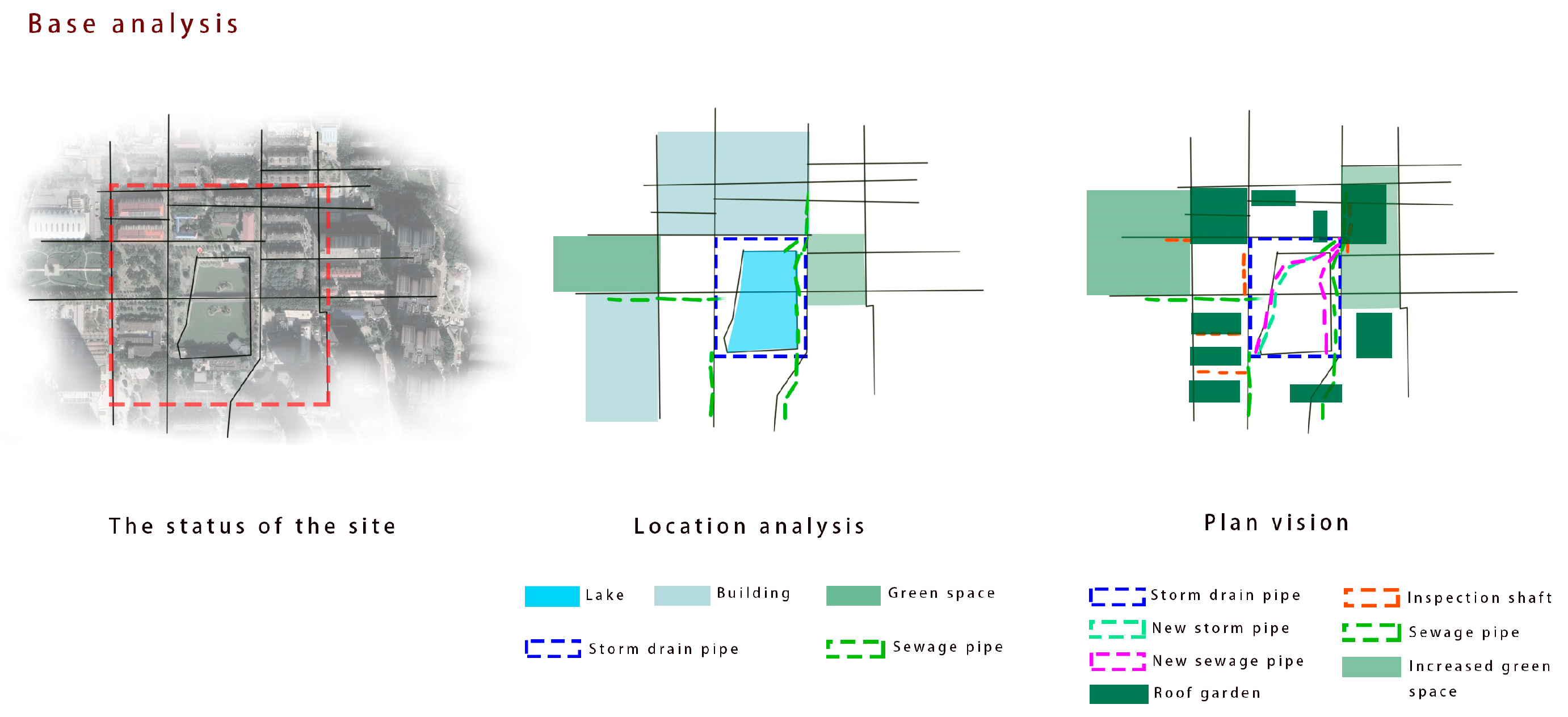
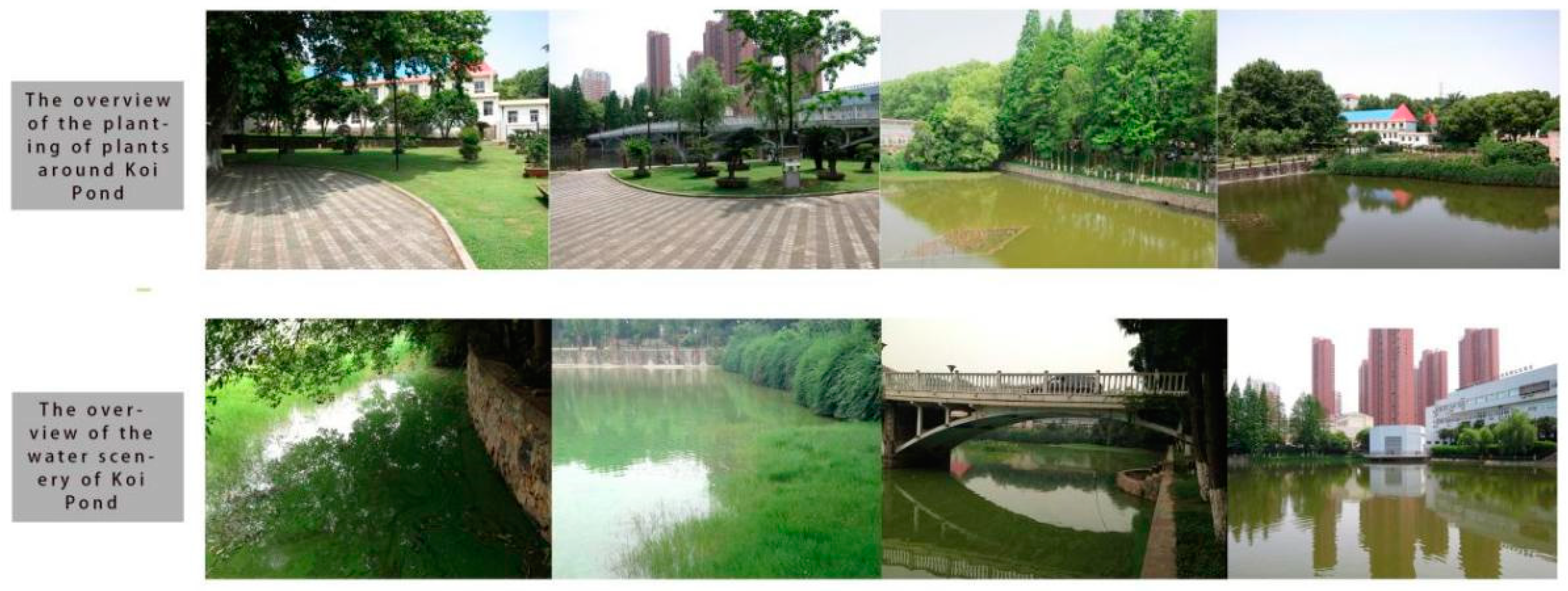
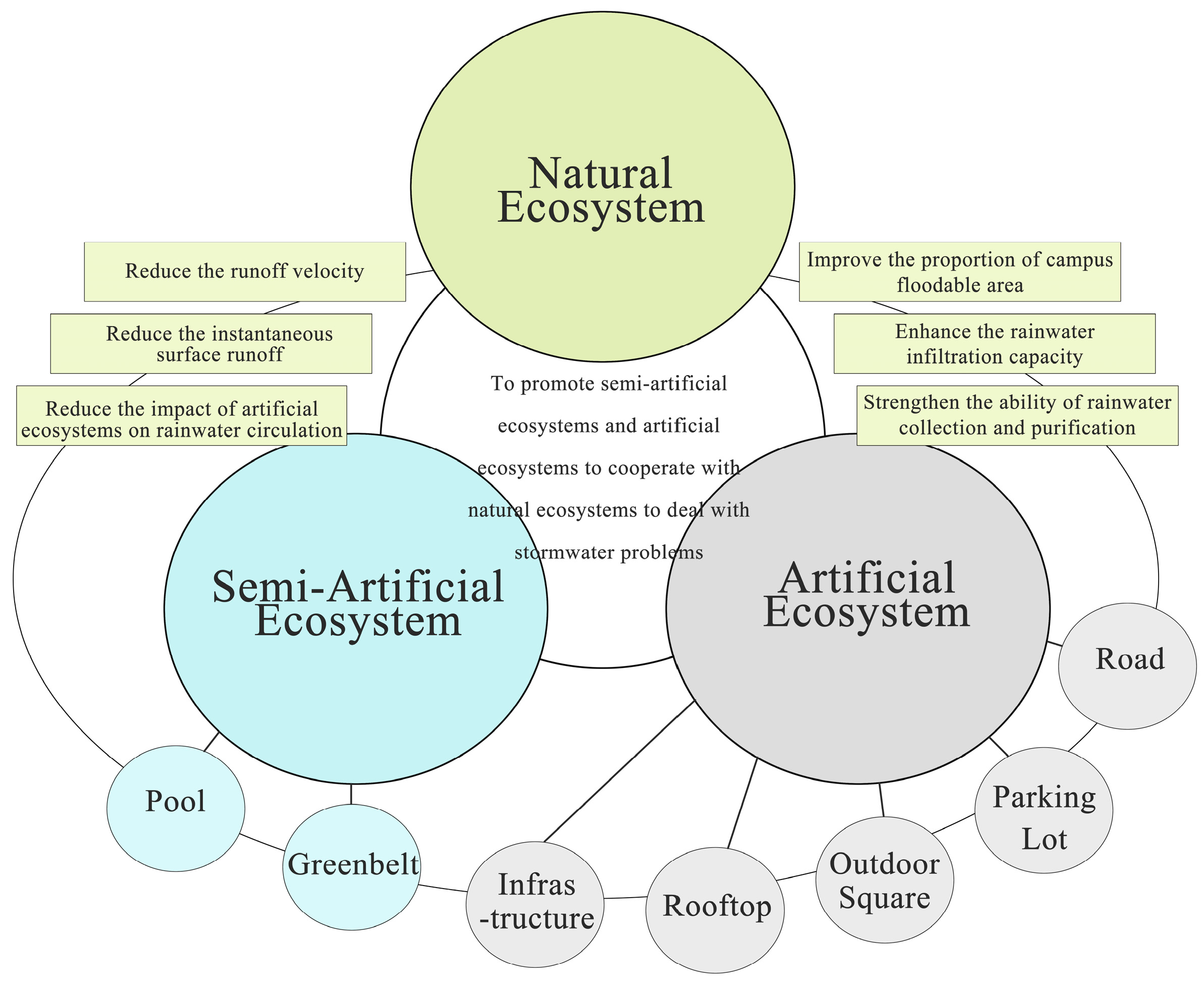
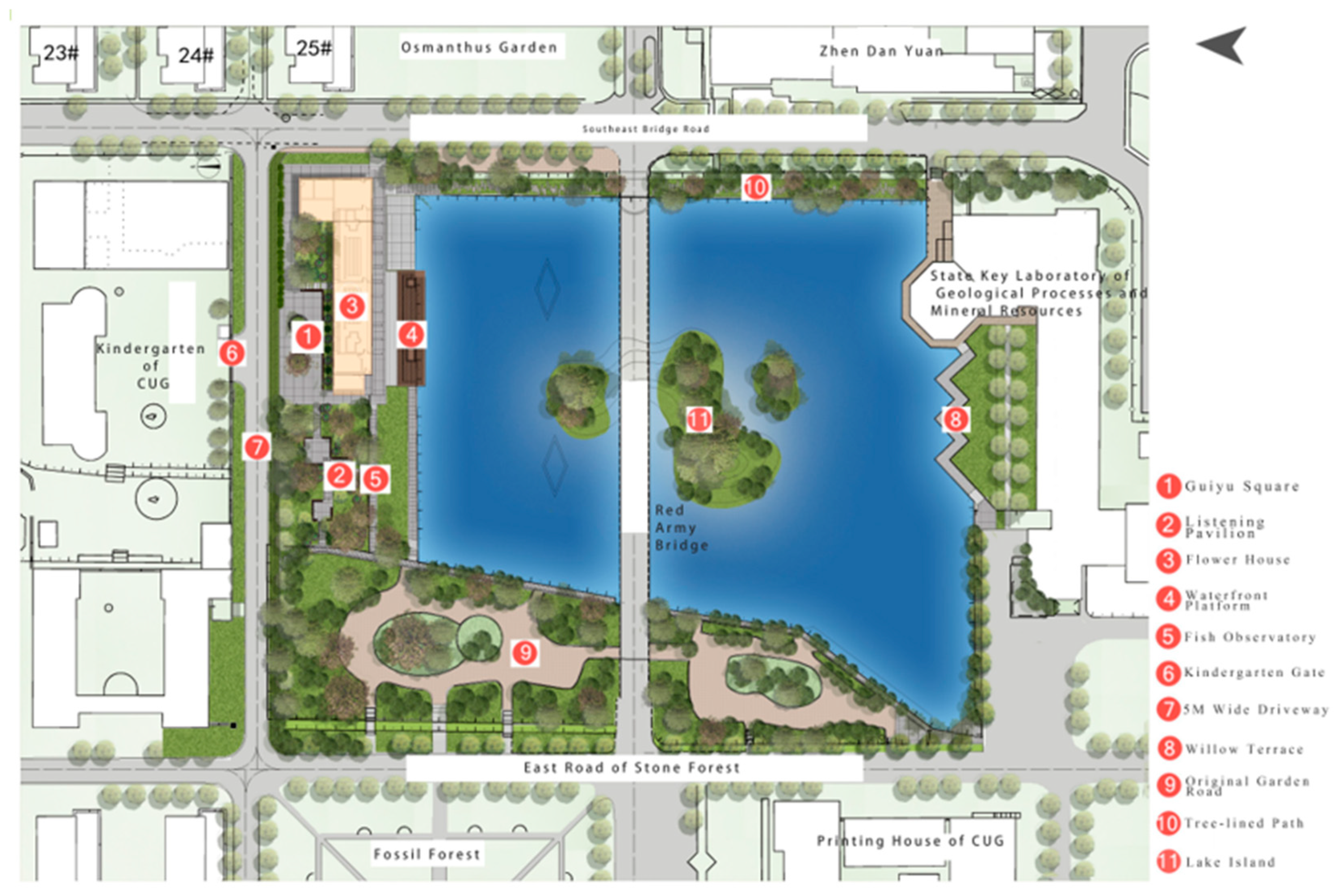
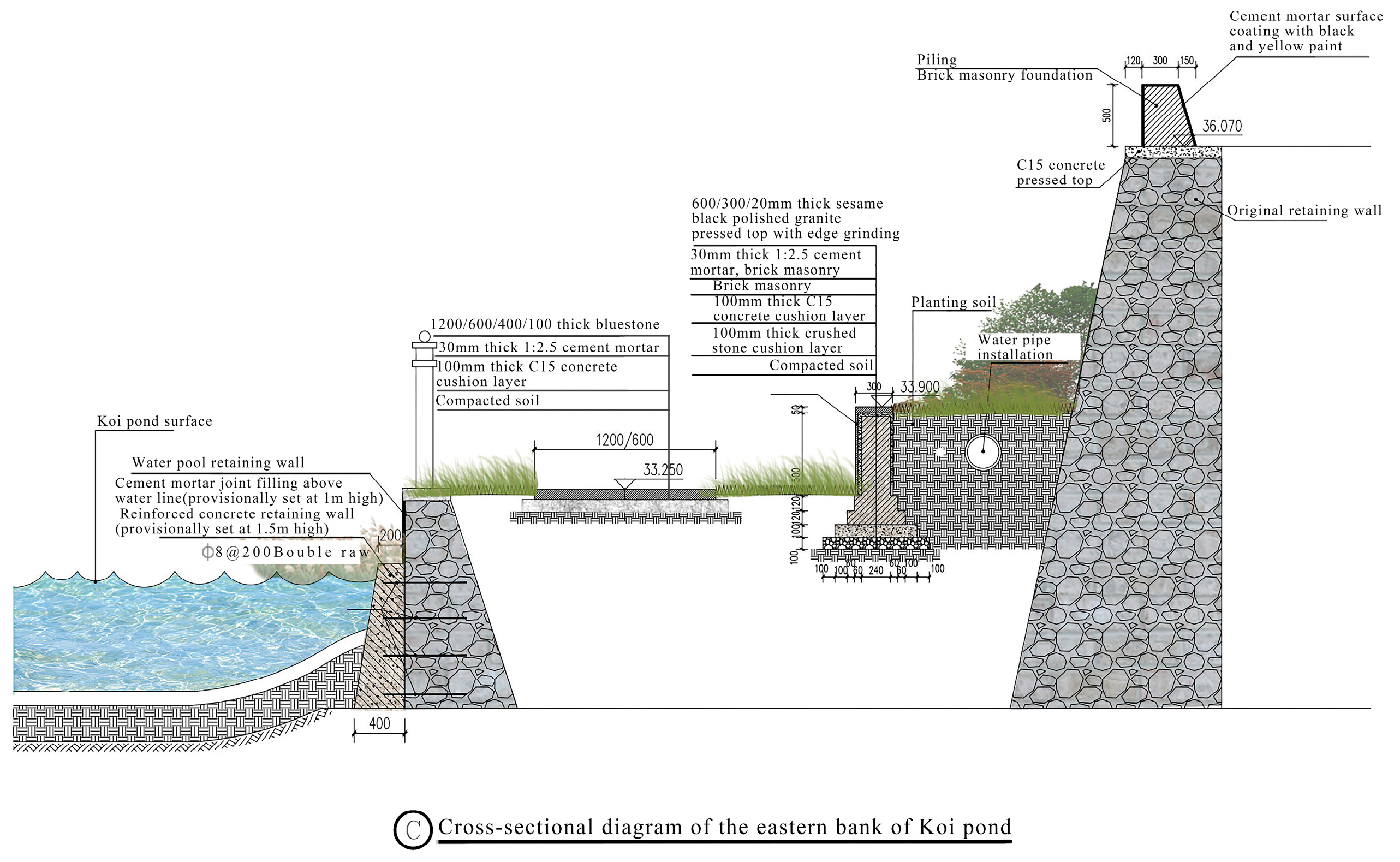
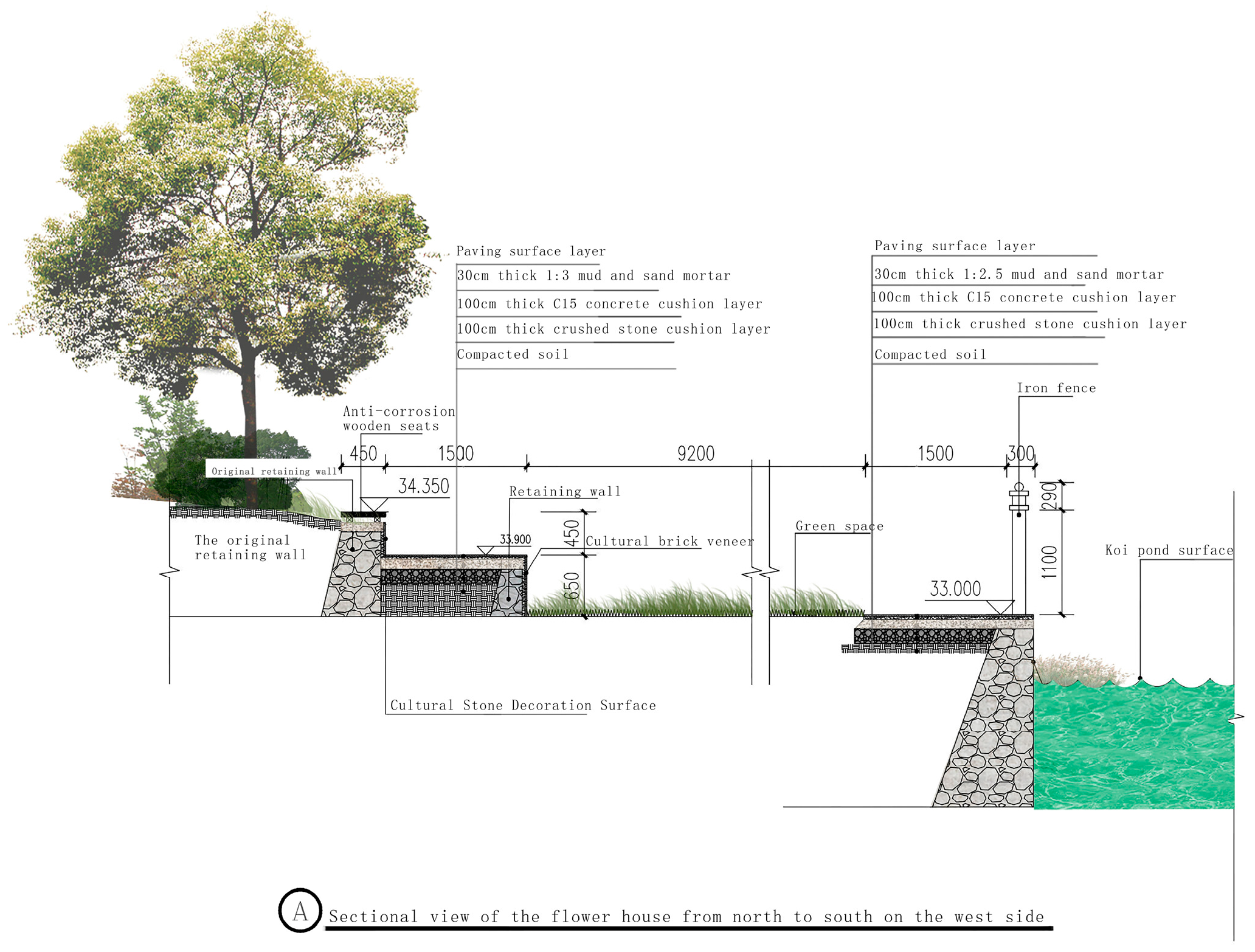
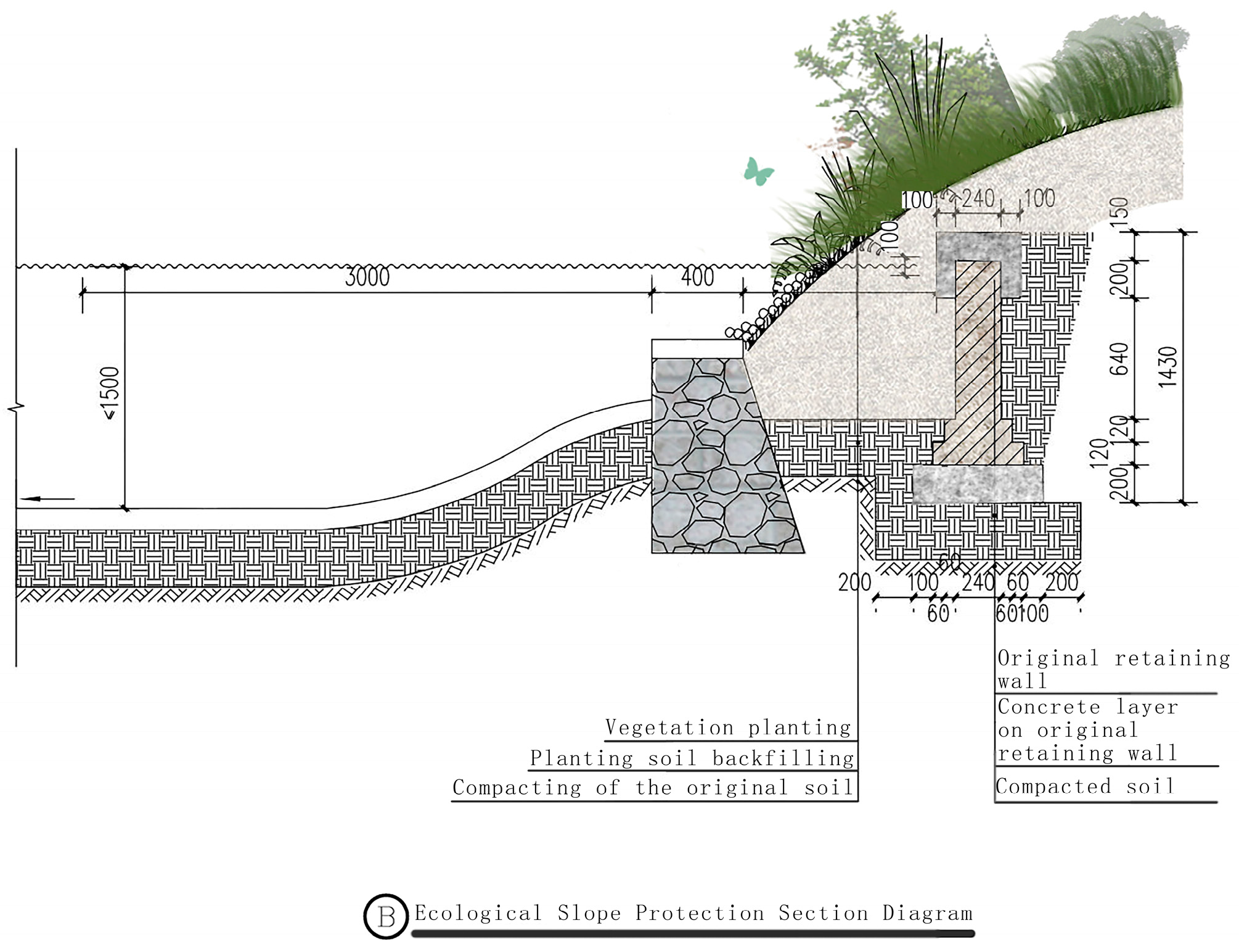
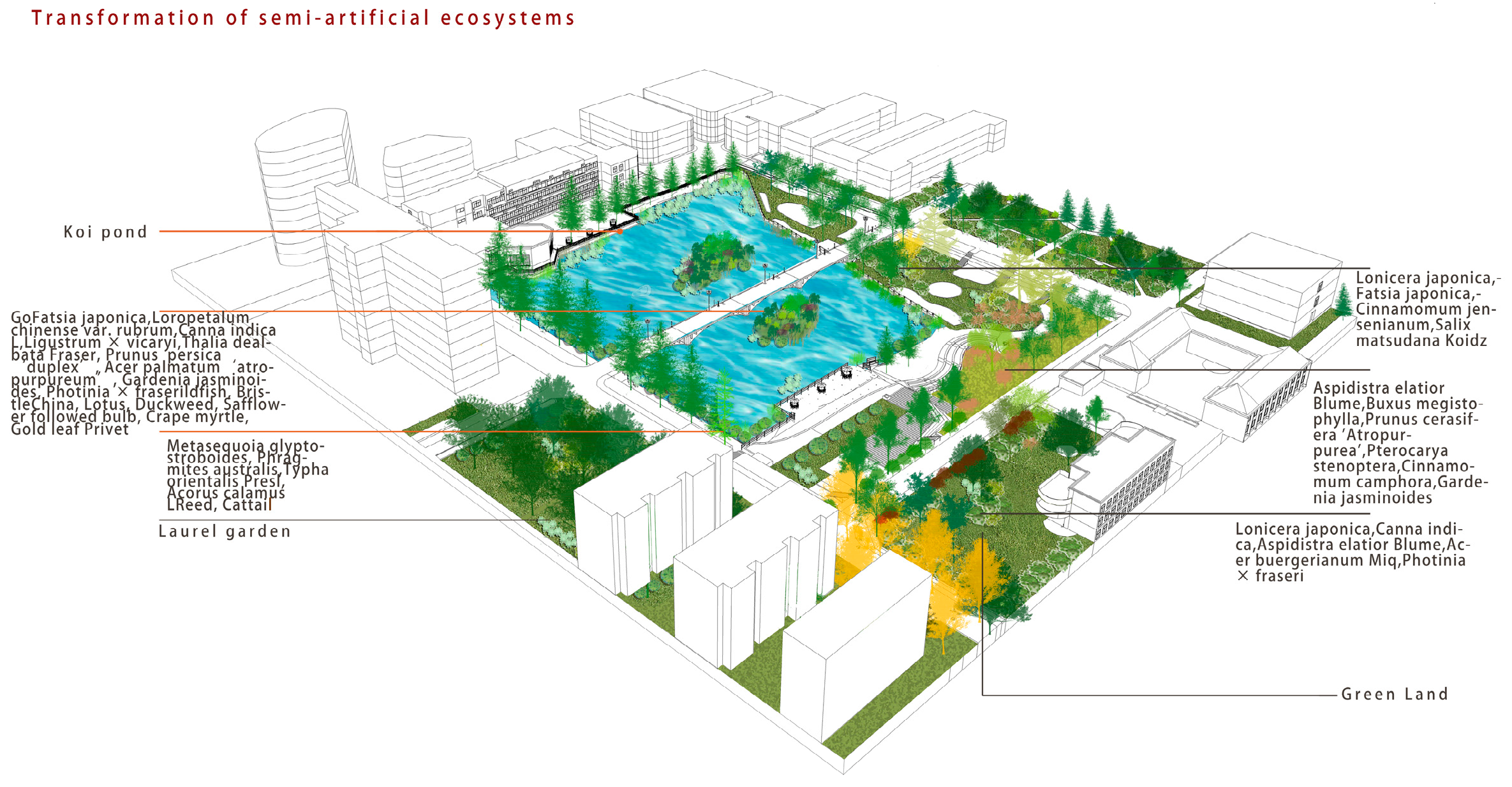
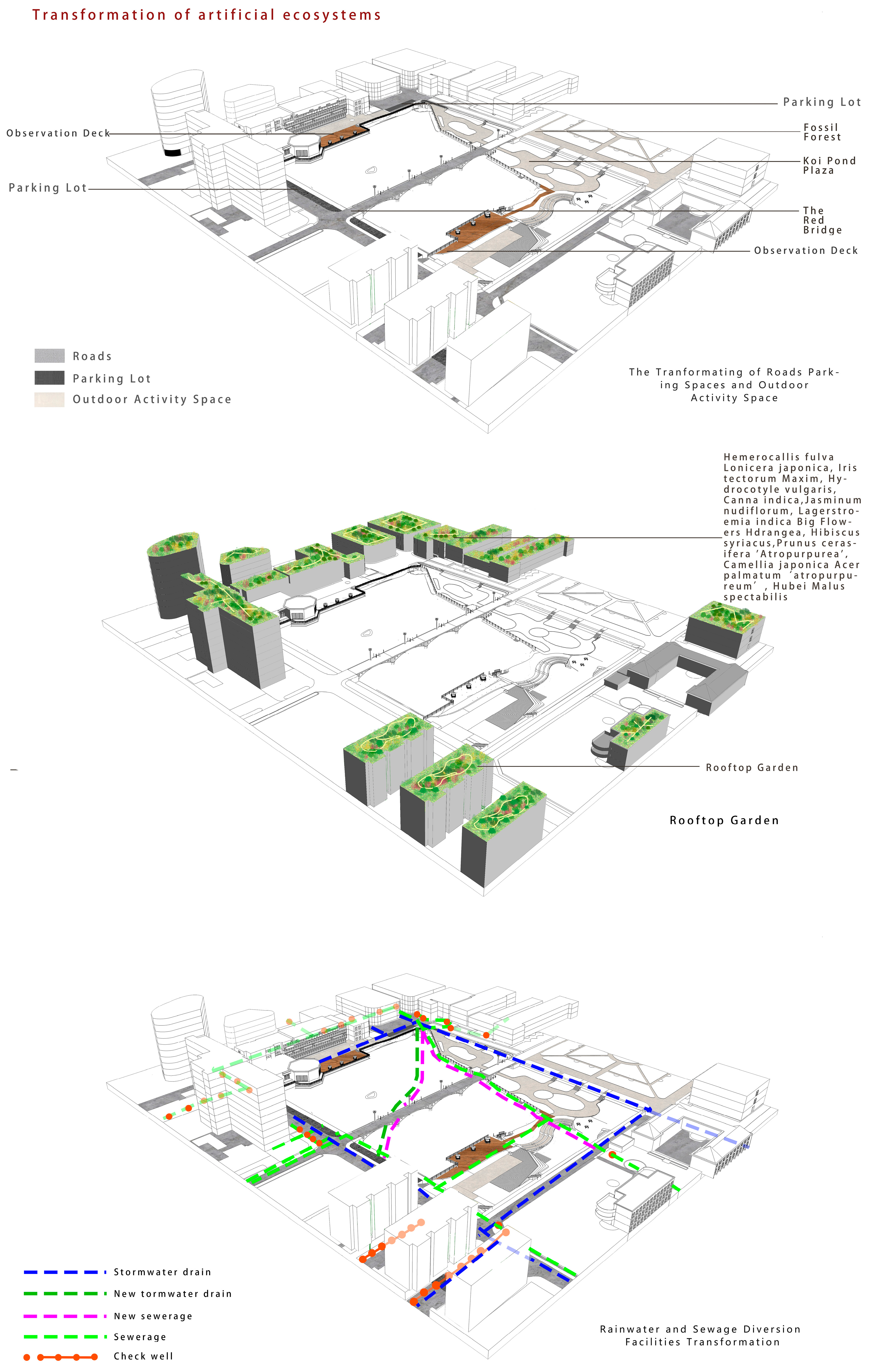

| The Ecological System | Strategy | Specific Application Site | Specific Strategies for Building Resilient College Campuses |
|---|---|---|---|
| Semi-artificial ecosystem | Improve the greening rate of the college campus | Koi pond | ① Plant aquatic plants and release aquatic animals to create wetland. ② Add cutoff wall to prevent water pollution caused by external and internal infiltration of pool water. |
| Green space | ① The configuration form of arbor-shrub-herb enriches the vertical structure level [27]. ② Increase the accessible landscape, and increase the leachable area integrating greening, rainwater retention, rest, and other functions. ③ Rain garden; concave green space; and vegetation gully. | ||
| Artificial ecosystem | ① Use permeable paving materials; ② The roof garden; ③ Update rainwater collection system and rainwater purification system. | Road | Vegetation gully |
| Parking lot | ① Use materials with strong water permeability. ② Buried water collection perforated pipe under the soil to collect rainwater. | ||
| Hard outdoor playground | ① Use materials with strong water permeability. | ||
| Building roof | ① Plants with high porosity roots, low density, and erosion resistance were selected. ② Waterproof material with root separation function [30]. ③ The storage and drainage disk is combined with the substrate layer and the moisture layer of the sintered soil. ④ Planting cold-tolerant, drought-resistant, native plants [32]. | ||
| Rainwater collection and purification facilities | Update and repair the rainwater collection and purification facilities [33]. |
| Different Regions | Recommended Plant | Function | |||
|---|---|---|---|---|---|
| Koi Pond Wetland | Alternating Dry and Wet Areas | Shallow Water Area | Deep Water | Lake Island | Build biodiversity, regulate microclimate, beautify environment, store rainwater, purify rainwater, reduce surface rainwater runoff, slow down water flow speed, and increase the area of the college campus that can absorb rainwater |
| <0.3 m | 0.3–0.6 m | 0.9–2.5 m | Fatsia japonica ((Thunb.) Decne. & Planch.), Loropetalum chinense ((R.Br.) Oliv.), Musa basjoo (Siebold ex Miq.), Lagerstroemia indica (L.), Ligustrum × vicaryi (Rehder), Thalia dealbata (Fraser), Acer palmatum (Raf.), Gardenia jasminoides (J.Ellis), and Photinia serrulata | ||
| Amphibious plants: Iris tectorum (Maxim), Typha orientalis (C. Presl), Lythrum salicaria (L.), Persicaria hydropiper ((L.) Delarbre) , and Acorus calamus (L.) | Water plants: Typha angustifolia (L.), Phragmites australis ((Cav.) Trin. ex Steud.), Nelumbo nucifera (Gaertn.), and Oenanthe javanica ((Blume) DC.) | Submerged plants: Myriophyllum verticillatum (L.) and Potamogeton distinctus (A.Benn.) Floating plants: Nelumbo nucifera (Gaertn.), Eichhornia crassipes ((Mart.) Solms), and Lemna minor (L.) | |||
| Building Roof | Herbaceous | Shrub | Trees | ||
| Hemerocallis fulva ((L.) L.) Lonicera japonica (Thunb.), Iris tectorum (Maxim), Hydrocotyle vulgaris (L.), and Canna indica (L.) | Jasminum nudiflorum (Lindl.), Lagerstroemia indica (L.), Hydrangea macrophylla ((Thunb.) Ser.), and Hibiscus syriacus (L.) | Prunus cerasifera (Ehrh.), Camellia japonica (L.), and Acer palmatum (Raf.) | |||
| Rain Garden | Lonicera japonica (Thunb.), Aspidistra elatior (Blume) Hydrocotyle vulgaris (L.) Juncus effusus (L.), and Canna indica (L.) | Aspidistra elatior (Blume) Buxus megistophylla (H.Lév.) and Euonymus japonicus ‘Aurea-marginatus’ | Pterocarya stenoptera (C.DC.), Acer buergerianum (Miq.), Cinnamomum camphora ((L.) J.Presl), and Bischofia polycarpa ((H.Lév.) Airy Shaw) | ||
| Vegetation Gully | Lonicera japonica (Thunb.), Hemerocallis fulva ((L.) L.), and Juncus effusus (L.) | Musa basjoo Siebold ex Miq. and Lagerstroemia indica (L.) | Acer buergerianum (Miq.) and Chimonanthus praecox ((L.) Link) | ||
| Other Green Space | Aspidistra elatior (Blume) and Lonicera japonica (Thunb.) | Buxus megistophylla (H.Lév.), Phoenix dactylifera (L.), Gardenia jasminoides (J.Ellis), Lagerstroemia indica (L.), Photinia serrulata, and Musa basjoo Siebold ex Miq. | Cinnamomum camphora ((L.) J. Presl), Pterocarya stenoptera (C.DC.), Platanus × acerifolia ((Aiton) Willd.), and Cinnamomum jensenianum (Hand.-Mazz.) | ||
Disclaimer/Publisher’s Note: The statements, opinions and data contained in all publications are solely those of the individual author(s) and contributor(s) and not of MDPI and/or the editor(s). MDPI and/or the editor(s) disclaim responsibility for any injury to people or property resulting from any ideas, methods, instructions or products referred to in the content. |
© 2023 by the authors. Licensee MDPI, Basel, Switzerland. This article is an open access article distributed under the terms and conditions of the Creative Commons Attribution (CC BY) license (https://creativecommons.org/licenses/by/4.0/).
Share and Cite
Li, S.; Zhu, Y.; Yang, J.; Gong, B. Research on Renewal Design of College Campus Based on Flood Bearing Resilience. Sustainability 2023, 15, 11489. https://doi.org/10.3390/su151511489
Li S, Zhu Y, Yang J, Gong B. Research on Renewal Design of College Campus Based on Flood Bearing Resilience. Sustainability. 2023; 15(15):11489. https://doi.org/10.3390/su151511489
Chicago/Turabian StyleLi, Shengfang, Yi Zhu, Jian Yang, and Bin Gong. 2023. "Research on Renewal Design of College Campus Based on Flood Bearing Resilience" Sustainability 15, no. 15: 11489. https://doi.org/10.3390/su151511489
APA StyleLi, S., Zhu, Y., Yang, J., & Gong, B. (2023). Research on Renewal Design of College Campus Based on Flood Bearing Resilience. Sustainability, 15(15), 11489. https://doi.org/10.3390/su151511489






